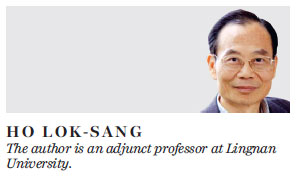A new approach to road pricing
Updated: 2016-05-24 07:07
By Ho Lok-Sang(HK Edition)
|
|||||||
Ho Lok-sang writes that congestion charges for busy traffic areas are a fact of modern life, so it behooves us to choose the fairest and most efficient system possible for HK
The government's consultation on a proposed electronic road pricing plan for Central has been over for quite some time, but it has yet to come up with a decision about the plan. Since I was an early proponent of introducing road pricing in Hong Kong, I feel it imperative to say a few things about it - in particular how it can be best implemented.
The theory about road pricing is very simple and is now quite standard in any urban economics course. In the absence of road pricing, motorists ignore the cost their presence imposes on all other motorists. Road utilization is likely to be more than optimal. In the worst cases, congestion can reduce the traffic flow altogether, i.e., even though the number of motorists has gone up, the number of vehicles that pass through a particular point per hour may actually become smaller. Charging the right road price potentially can make everybody happier compared to a regime without a road price.

This last statement may seem paradoxical or surprising, but it is nevertheless true. The road price reduces congestion by discouraging some motorists from driving on specific roads. The discouraged traffic usually represents a loss: These motorists refrain from making the trip or they use alternative modes of transport such as the MTR because with the road price the trip is no longer worthwhile. Without the road price, the trip would have been made.
It is important to realize motorists that are discouraged are not specific to anyone in particular. Every motorist will have times when they feel the trip is worth undertaking, and will also have times when they feel a trip is not worthwhile because of the road price. Road pricing gives every road user the comfort of knowing that when they want to use the roads, they will be able to. They will pay a price, but will save time, and will have a lower chance of being caught in an unfortunate traffic jam which could potentially be extremely costly.
This does not even count the reduction in pollution that results when the heavy traffic is delayed but still emitting pollutants.
I will now proceed to discuss how to implement electronic road pricing in order to bring about the best results.
Practically all the proposals rely on the "trigger-to-charge" mechanism. Vehicles will be detected upon passing a trigger point and will be charged. This is much like the auto-toll mechanism which drivers should be quite familiar with, as most if not all the toll-paying tunnels today provide lanes for vehicles with the remote sensing emitters.
The trigger-to-charge mechanism has several disadvantages. First, two vehicles that trigger the same charge may cause vastly different degrees of congestion. One can stay around on the roadside or drive around past the trigger point while waiting for someone, whereas another one passes the point and goes away. Second, since each time a vehicle passes the trigger point a charge is imposed, there will be an incentive for the driver not to pass that point again. So the mechanism may actually invite more congestion by keeping the vehicle "past" the trigger point. Third, if the charge is to change with the extent of congestion, such changes have to be done manually.
An alternative, and in my view, far superior system is to charge a vehicle for the time it stays within a "charge zone". When a vehicle goes into the zone, "time in" is marked; when it goes out of the zone, "time out" is noted. The vehicle will be charged according to the number of minutes it has stayed within the charge zone. With today's technology this is not difficult to do. An obvious advantage of charging by the number of minutes within the charge zone is that if the congestion flow is slow then the duration of stay will be longer. As a result the motorist will be charged more. If there is no congestion, traffic flow will be smooth then the charge will be automatically reduced. Moreover, a vehicle that stays within the charge zone longer will be charged more, regardless of the reason. Thus a vehicle that breaks down will be charged more, prompting owners to pay more attention to vehicle maintenance. A vehicle which parks legally in the zone can be read as temporarily out of the charge zone. One that parks illegally will continue to be charged for every minute it stays within the zone. This will not be possible with the trigger-to-charge mechanism.
It is natural for people to object to any new tax or new charge or price increase. This kind of knee-jerk reaction, however, is not rational. In a modern city like Hong Kong the cost of time is very high, and the cost of miscalculation is also extremely high. Many of the great cities of the world, including London and Singapore, have already implemented road pricing for a long time. To work smarter, we need to abandon archaic thinking that a road price is a tax and a tax is to be resisted.
(HK Edition 05/24/2016 page10)